
The adjective "anhydrous" qualifies the element that lacks water.
Anhydrous is an adjective that is used in the field of chemistry to describe the substance that lacks water . The term comes from the Greek word ánydros , which translates precisely as “that has no water.”
Natural or processed
In some cases, the anhydrous element never has water in its structure. However, sometimes a substance has water and then loses it, thereby becoming anhydrous.
To make a solvent anhydrous, it is usual to boil it together with a hygroscopic substance (that is, capable of absorbing moisture). Another possibility is to use a molecular sieve .
When the presence of water affects the development of a desired compound, a chemical reaction can be promoted to obtain an anhydrous compound. In this framework, hygroscopic materials are used that capture moisture.
anhydrous ethyl alcohol
Anhydrous ethyl alcohol , for example, is produced using molecular sieves that promote clean dehydration of ethanol . This chemical compound is also known by the name anhydrous ethanol and the substance from which we must start to obtain it is the so-called rectified alcohol . Its minimum purity level value is 99.6 percent.
Since the use of molecular sieves is so common to achieve anhydrous alcohol, let's look at some details of this concept. It is a material that has pores whose size is comparable to that of small molecules . Thanks to this essential characteristic, the largest ones cannot pass through.
Regarding its most common applications, we can mention the raw material for products such as fuel alcohol, drinking alcohol or solvents, as well as others in the field of perfumery or the pharmaceutical industry. Above we talked about the possibility of transforming a compound into anhydrous, and this is an example of such a process; In this particular case, dehydration is used, passing the rectified alcohol through a system that removes the water.
Anhydrous sodium sulfate
Anhydrous sodium sulfate, which is also known as disodium sulfate , among other possibilities, is a colorless, crystalline substance , very soluble in water but poorly soluble in almost all organic solvents, except for glycerin. To dissolve it in water, it is cooled and the entropic effect is used. This provides energy, which is released by the salt when it is hydrated and dissolved.
Regarding its applications, they are several and diverse. Let's start by mentioning that its hygroscopic properties (absorb moisture from its environment) make it ideal for use in the chemical industry and in the laboratory. On the other hand, it is used to make cellulose and, as an additive, for glass and plastic.
Powdered detergents acquire better mechanical behavior thanks to anhydrous sodium sulfate, in addition to considerably increasing their weight. It can also serve as a disinfectant, although it doesn't take long for it to become irritating. If combined with activated charcoal, it can accelerate intestinal transit and reduce the absorption of ingested toxins. Finally, it acts as an acidulant in the gastronomic field.

Because of its ability to absorb moisture, anhydrous sodium sulfate is used in the laboratory and industry.
anhydrous copper sulphate
Anhydrous copper sulfate , on the other hand, is a grayish powder. If it is reacted with water, copper sulfate pentahydrate is generated, which is used as an algaecide, fungicide, fertilizer and veterinary medicine.
It all starts with copper or cupric sulfate, a solid crystalline compound whose most common form is the pentahydrate , with a bright blue color. When it is brought to high temperatures, it loses its water molecules: the first four, when it reaches 110 degrees Celsius; the last, when it reaches 150. Anhydrous copper sulfate appears there.
